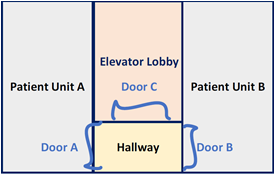Risk Management has been a fundamental aspect of our work with the Neuro Diagnostic Institute (NDI) located on the campus of Community East Hospital in Indianapolis throughout the building design, physical construction, patient move planning, and process and policy implementation. Risks spanned across different categories such as Patient Safety, Building Infrastructure, Staff Performance and Quality, and Project Schedule. Here are some interesting insights and examples I learned while working on the project. Read about some specific examples here.
Furniture Risk: Most furniture is filled with sand for weight to reduce the risk of it being picked up and used as a weapon. Shown here is an example of this in the patient dining area on a unit.
Staff Communication: It is possible a staff member may find themselves in a dangerous situation with a patient and needs to call for staff assistance. A robust communication plan and policy has been implemented, along with the roll-out of a hands-free communication device. The policy dictates what different codes mean and who should respond when they are called.
Building Security: Due to the nature of the patient profiles, the hospital must utilize strict security measures. To reduce the risk of patients entering restricted areas, a complex badge reader, key, doorway, and elevator system was designed specifically for this purpose.
One example involves programming doors to reduce “escape” risks as shown. Consider a floor that has two different patient units. Imagine Patients on unit A and unit B must not interact with each other for some reason. If a patient (called Patient A) was being transported from Unit A to another floor it would look like this.
- Staff member escorts patient A through Door A using badge. Doors B and C will not open until Door A is closed.
- Once the staff member and Patient A are in the Hallway and Door A is closed, the staff member will use the badge reader again to open Door C. Once Door C is open, A and B will not open until Door C is closed.
As you can see, this kind of programming greatly reduces the odds of a patient from unit A, getting to unit B. Keep in mind this is just an example to illustrate the concept and not necessarily the exact method utilized at the NDI.
Ligature Risk: Patient safety is a top priority to hospital leadership. Anti-ligature considerations have been included in all aspects of the building to reduce the risk of self-harm. Anti-ligature design serves to eliminate points where a rope, cord, bedsheet, etc. could be looped or tied. Examples of this are seen in the short phone cords on the patient’s units, slanted and curved door handles, and modified towel racks in the bathrooms.
Utilities and Appliances: It is possible a patient may insert objects or body parts into open outlets and plugs. Most patient bedrooms do not have power outlets. If they do have outlets, staff can turn that outlet on and off, based on the patient. Another example is seen in the patient bathrooms. The hand dryers are designed in a way so that there are no open gaps in the blower. Bathroom drains are designed the same way.
This small sample of examples illustrates the rigorous risk management strategies necessary to maintain Patient Safety in a psychiatric hospital. Risk planning, response, and mitigation should occur throughout all phases of a project and consistently be monitored. The failure to properly engage in risk management techniques within this environment could result in harm to a staff member or patient.

Andrew is a Senior Consultant with over ten years of experience in a variety of fields related to Medicaid IT systems, hospital Construction and technical integration, public health, telecommunications, and residential construction. He’s currently a Project Manager for The My Healthy Baby Program which is a state operated program that connects pregnant Hoosiers to local services all across Indiana.
Andrew holds a PMP Certification and is a certified Scrummaster.



